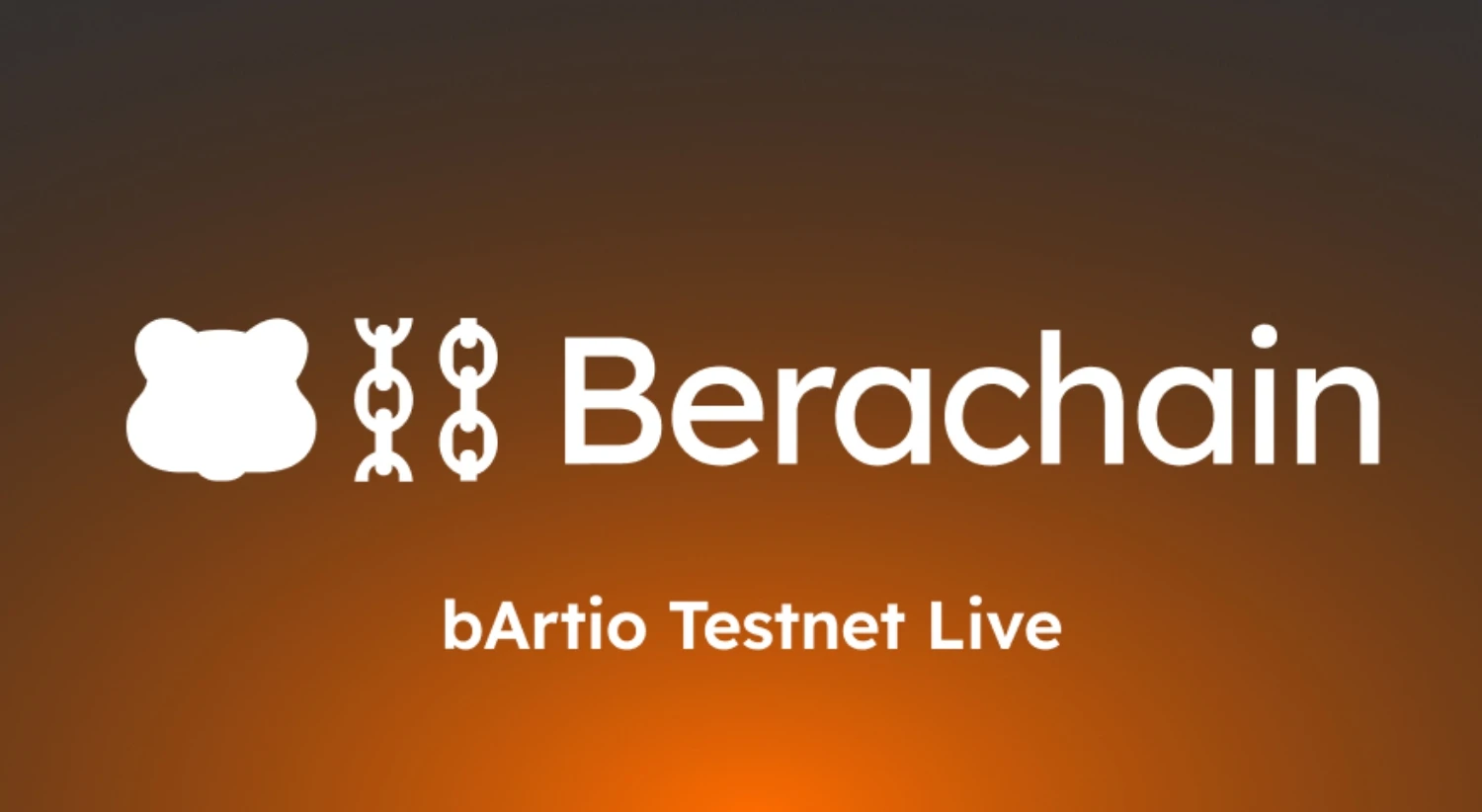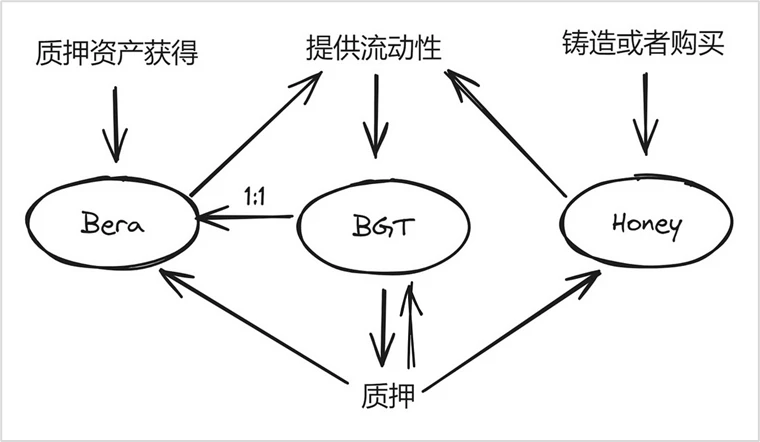
I. Technical Architecture: Dual Innovation of PoL Mechanism and Three-Token Model
1.1 Proof of Liquidity (PoL): Redefining Consensus Mechanism
Berachain's Proof of Liquidity (PoL) is its core innovation. Unlike traditional PoS mechanisms, PoL requires validators to maintain network security by providing liquidity (rather than merely staking tokens). This design directly converts on-chain economic activities into security resources, forming a closed loop of "liquidity equals security." According to testnet data, the PoL mechanism allows Berachain's liquidity utilization rate to reach 91%, far exceeding Ethereum (approximately 65%) and Solana (approximately 72%).
Technical implementation details:
Reward distribution model: 70% of block rewards flow to the dApps reward pool, with the remaining 30% distributed to validators, incentivizing ecological applications to self-generate revenue;
Dynamic staking algorithm: The earnings of validators are positively correlated with the activity level of the liquidity pools they manage, with the formula:

- Anti-MEV strategy: Adopts batch order processing (Batch-A2MM) and off-chain matching to reduce the risk of sandwich attacks.
1.2 Three-Token System: Economic Synergy of BERA, HONEY, and BGT
Berachain's token model achieves ecological balance through functional separation:
BERA: Gas token used to pay transaction fees; staking validators need to consume BERA to activate nodes;
HONEY: Over-collateralized stablecoin that maintains its peg through a dynamic interest rate model (base rate ± market fluctuations), with a pre-stored TVL of $1.6 billion on the mainnet;
BGT: Non-transferable governance token obtained through liquidity mining, allowing holders to vote on protocol upgrades and resource allocation. Testnet data shows that 68% of BGT holders participate in governance proposals, validating the effectiveness of the token design.

Source: Berachain Honeypaper, Three-Token Interaction Model
II. Ecological Map: DeFi Legos and Cross-Chain Collaboration Network
2.1 Core Protocol: Building Financial Infrastructure
Berachain has formed a complete DeFi matrix covering scenarios such as trading, lending, and derivatives:
Kodiak: A native DEX supporting Uniswap V3-style concentrated liquidity, dynamically adjusting LP ranges through the "Island" feature, with over 100,000 interactions recorded on the testnet. Its smart contracts use a layered architecture, optimizing gas consumption by 40%;
Dolomite: A leveraged mining protocol that allows users to stake BGT for 5x yield amplification, combined with the veDOLO token model to lock in long-term liquidity, with TVL exceeding $120 million;
Infrared Finance: A liquidity staking protocol that converts BGT into iBGT, allowing users to earn both staking rewards and DeFi portfolio returns, with a TVL of $273 million and an annualized return rate of 19-37%.
2.2 Strategic Cooperation: Cross-Chain Liquidity Capital Network
Berachain builds cross-chain liquidity pools through partnerships with leading protocols:
Stakestone: A full-chain liquidity protocol introducing STONE assets, with its pre-stored Vault attracting $111 million in just 24 hours, making the beraSTONE/ETH pool the largest liquidity pool on Uniswap V3;
Ethena: The synthetic dollar protocol USDe integrates into the ecosystem, allowing users to capture 37% annualized returns and ecological airdrops, with pre-stored USDe reaching $430 million;
Lombard: A Bitcoin DeFi protocol that brings wBTC into the ecosystem, achieving cross-chain capital appreciation through a four-tier yield structure, with APY exceeding 45%.

Data: https://dune.com/lindyhan/berachain-pre-boyco-deposits
III. Data Performance: Testnet Explosion and Mainnet Accumulation
3.1 Testnet Milestones: Dual Growth of Users and Developers
User scale: The v2 Bartio testnet saw independent addresses surge from 6.4 million to 240 million, with daily active peaks reaching 7 million, surpassing Avalanche's data during the same period;
Interaction frequency: DEX trading, stablecoin minting, and other tasks completed a total of 27 million operations, with transactions per second (TPS) reaching 2,300;
Developer ecosystem: Over 270 projects have been deployed, with 35% focusing on RWA and 23% on GameFi, showing significant ecological diversity.
3.2 Mainnet Expectations: Dual Momentum of Capital and Community
Through the Boyco pre-storing activity, Berachain has locked in $3.1 billion in assets, covering ETH, BTC, and stablecoins. Airdrop rules indicate:
2% of BERA is allocated to liquidity providers, with early participants eligible for 5x weight rewards;
Bong Bears NFT holders enjoy priority governance rights, with airdrop shares accounting for 1.5% of the total supply;
Testnet contributors are expected to share 2%-5% of the token supply, incentivizing long-term ecological development.
IV. Future Outlook: Technological Evolution and Ecological Challenges
4.1 Technical Roadmap: From Quantum Security to Causal Inference
Quantum resistance: A cryptographic module resistant to Shor's algorithm will be launched in Q1 2025 to address quantum computing threats;
Causal inference engine: Integrates AI models to analyze on-chain data, providing 48-hour advance warnings for liquidity fluctuations (with an accuracy rate of 82%);
Modular expansion: Collaborating with Particle Network to develop a chain abstraction layer that supports one-click interaction of multi-chain assets.
4.2 Potential Risks and Response Strategies
Token model pressure: The non-transferability of BGT may limit secondary market liquidity; solutions include introducing iBGT liquidity certificates;
Stablecoin stability: HONEY needs to address the risk of decoupling during extreme market conditions (historical maximum deviation of 1.7%), with plans to introduce a dynamic collateral rate adjustment mechanism;
Ecological cold start: The mainnet needs to maintain an average of 1 million active addresses daily, attracting users through continuous airdrops and developer incentive programs.
V. Industry Comparison: Berachain's Differentiated Competitive Edge
5.1 Differentiation from Ethereum
Consensus mechanism: PoL vs. PoS, Berachain directly converts liquidity into security resources, while Ethereum relies on staked capital;
Economic model: The three-token system separates functions, reducing the impact of single asset volatility on the ecosystem, while Ethereum relies on ETH to assume multiple roles;
User experience: Achieves "zero gas fee launch" through the Boyco pre-storing activity, while Ethereum Layer 2 still requires payment of base fees.
5.2 Performance Comparison with Solana
Throughput: Berachain's testnet TPS reaches 2,300, close to Solana's 5,000, but optimizes resource allocation through PoL;
Fee structure: Berachain's HONEY stablecoin reduces transaction costs, while Solana relies on SOL for payments, making it more susceptible to price fluctuations;
Ecological positioning: Berachain focuses on DeFi and RWA, while Solana leans towards high-frequency trading and NFTs.
Conclusion: A New Paradigm of Liquidity Democratization
Berachain reconstructs the value distribution logic of public chains through the PoL mechanism and three-token model. When Kodiak's "Island" feature pushes capital utilization to 91%, and when Stakestone's beraSTONE surpasses stETH to become the largest yield-bearing asset, we see not just technological iteration but a paradigm revolution in liquidity democratization. As its white paper states: "Berachain is not just another EVM chain, but a new continent of economic collaboration." Despite facing challenges with the token model and ecological cold start, this liquidity-driven experiment has already opened up a new imaginative space for Web3 finance.
免责声明:本文章仅代表作者个人观点,不代表本平台的立场和观点。本文章仅供信息分享,不构成对任何人的任何投资建议。用户与作者之间的任何争议,与本平台无关。如网页中刊载的文章或图片涉及侵权,请提供相关的权利证明和身份证明发送邮件到support@aicoin.com,本平台相关工作人员将会进行核查。




